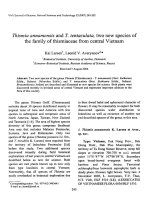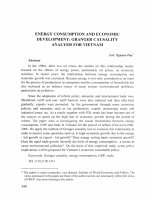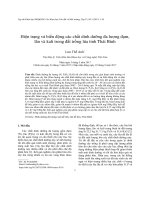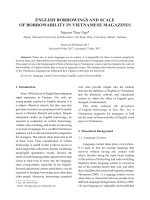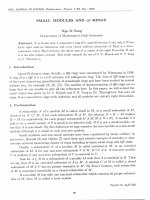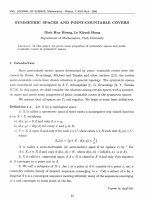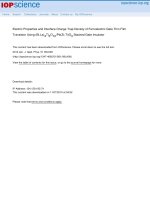DSpace at VNU: Small modules and Qf-Rings
Bạn đang xem bản rút gọn của tài liệu. Xem và tải ngay bản đầy đủ của tài liệu tại đây (2.36 MB, 5 trang )
V N U . JO U R N A L OF SC IE N C E , M a th e m a tic s - Physics.
T.xx,
N q2 - 2004
S M A L L M O D U L E S A N D Q F -R IN G S
N g o Si T u n g
Department o f Mathematics, Vinh University
A b s t r a c t . It is shown that a semiperfect ring R is quasi-Frobenius if and only if R has
finite right uniform dimension and every closed uniform submodule of R(u ) is a direct
summand where R(u>) denotes the direct sum of UJ copies of the right R -module R and
u is the first infinite ordinal. This result extends the one of D. V. Huynh and N. s. Tung
in [5. Theorem 1].
1. I n t r o d u c t i o n
Quasi-Frobenius rings (briefly, a QF-ring) were introduced by Nakayama in 1938.
A ring R is a Q F if it is a left artinian, left seflinjective ring. The class of QF-rings is one
of the most interesting generlization of semisimple rings and have been studied by several
authors (see, for example [4], [5], [7]). The number of characterization of QF-rmgs are so
large th at we are unable to give all the references here. In this paper, we will extend the
result which was given by D. V. H uynh and N. s. Tung in [5]. Throughtout this note all
rings R are associative rings w ith indentity and all modules are unitary right /ỉ-inođules.
2. P r e l i m i n a r i e s
A submodule N of a module M is called small in M , or a small submodule of M,
denoted by N c ° M , if for each submodule II of M, the relation N + II = M implies
II = M (or equivalently for each proper submodule II of M, M ^ N + II). A module s is
said to be a small module, if s is small in its injective hull. If s is not a small module, we
say th a t s is non-small. By this definition we may consider the zero module as a non-small
module although it is small in each non-zero module.
Small modules a n d non-small modules have been considered by many authors. In
particular H arada [3] and Oshiro [7] used these and related concepts of modules to char
acterize serveral interesting classes of rings including artinian serial rings and QF-rmgs.
Dually a subm odule E of a module M is called essential in M , or an essential
submodule of M , if for any non-zero submodule T of M, E n 7' / 0. A non-zero module
Ư is u n i f o r m if a n y n o n - z e r o s u b m o d u l e o f Ư is e s s e n ti a l i n u .
Now let A c B be a submodule of a module M such th a t A is essential in B. I h e n
we say th a t B is an essential extension of A in M . A module c of M is called a closed
submodule of M if c has no proper essension in M . By Zorn’s Lemma, each submodule
of M is contained essentially in a closed submodule of M .
If a module M has only one maximal submodule which contains all proper submodUỈ6S o f Af, th e n Ad is callcd. a local TTiodulc.
Typeset by ^4y\zf5-T^X
•39
40
N g o Si Tung
3. T h e r e s u lts
L e m m a 1. i) I f N is a non-zero small submodule of module M then N is a small module.
ii) Let M be a local module such that any closed submodule o f M is non-small.
Then M is uniform.
in) Let A, B be modules with A = B, then A is small i f and only if B is small.
Proof, i) Since N is submodule of M , E ( M ) = E ( N ) ® Y for some submodule Y of E ( M ) .
Since N c ° M , N c ° E ( M ) . By [6, Lemma 4.2(2)] we have N is a small submodule of
E(N), therefore N is small module.
ii) Is obvious.
iii) Since A = B there is an isomorphism
Hence the statement follows from [6, Lemma 4.2(3)].
L e m m a 2. [1, Chapter 27] Let R be a semiperfect ring, then R contains a complete set
of primitive orthogonal idempotents { e i , e2, e n } such that
R = e i R © e2R ® • • • ® enR
(1 )
and each eịR is a local module with local endomorphism ring. Moreover, the maximal
submodule of each ôịR is a small submodule of t{R.
We keep this decomposition of R thoughout the consideration below.
L e m m a 3. Let R be a semiperfect ring satifies one of two conditions:
a) Every closed submodule of R ( u ) is non-small.
b) R has finite right uniform dimension and every closed uniform submodule of
R( lj) is non-small.
Then we have:
i) Every el R is uniform.
u) Each CịR is not embedded properly in eJR ) j = 1, 2 , n.
in) Every closed uniform submodule of R ( uj) is a direct summand.
Proof. Case 1: R satisfies a).
i) By (1), each closed submodule u of eịR is closed in #0*0, hence u is non-small
by a). If u is non-zero then ei R = U ) which shows that ôịR is uniform.
ii) By i) and (1) each e ịR is a closed uniform submodule of
Hence et R is
n o n -sm all by a).
Then by Lemma 1, each eịR can not embedded properly in 6 j R , ( j = 1,
iii) For convenience we write R ( uj) in the form:
f l M = © a € /P a ,
(2)
where each PQ is isomorphism to some d R in {exR }. . . , en R } and I is an infinite countable
set.
S m a l l modules and QF-rings
41
By i) each Pa is uniform. Let Ư be a closed uniform submodule of R(u). For each
a we denote by7Tathe projection of R ( uj) onto Pa .
Then there exists a subset J of I which is maximal with respect to u n R ( J ) = 0
and u © R (J) c ° R ( uj). We show that there exists only k E I such that J = I \ { k } .
Indeed, suppose there exists kị Ỷ ^2 ị J let
Xi = p kl n (R(J) ® U) ,
* 2 = Pk2 n (R (J) © U ) .
Since R ( J ) © u c ° iỉ(u;), Xỵ Ỷ 0, x 2 Ỷ 0. Let
X = (Pkì © Pk2) n (R (J) © U ) .
Then X \ + Ẩ 2 c X and X n R ( J ) = 0. Consider the projection 7T : R Ụ ) —ì u , from
X n R ( J ) = 0 we infer that 71/ X is a monomorphism, hence X = 7t(X) c u . Thus X
contains a submodule which is isomorphism with X \ © ^ 2 , a contradiction to the fact that
Ư is uniform.
Therefore, there is only index k € I such th at J = /\{fc}. Then, we have [/nker 7T/c =
0. Hence Ư = 7T/t([/) c Pk. By hypothesis, u is non-small, hence 7Tfc([/) is also non-small
by Lemma 1. It follows that Pfc = 7Tfc([/), since Pk is a local module.
P r o m t h i s , i t i s e a s y t o s e e t h a t i? ( u ; ) =
u©
k e r 7Tjfc a s d e s i r e d .
Case 2: /Ỉ satisfies 6).
By the hypothesis ò), Ư is non-small, since eĩ R is a local module then each proper
submodule of CịR is small. Hence ư = e ị R 1 otherword eịR is uniform, we have i).
i) and iii) can prove similarly.
The following theorem was given by D. V. Huynh and N. s. Tung in [5].
T h e o r e m 4. Let R be a semiperfect ring. Then the following statements are equavelent:
i) R is a QF-ring.
ii) R has finite right uniform dimension, no non-zero projective right ideal of R is
contained in the jacobson radical J (R ) of R and every closed uniform submodule of R(u)
is a direct summand.
Now we prove our main theorem.
T h e o r e m 5. A seinipcrfect ring R is a QF i f and only i f R has finite right uniform
dimension and every closed uniform submodule of R(u>) is a direct summand.
Proof. (=>) Suppose that semiperfect ring R is a QF-ring. Then every closed submodule
of R ( uj) is non-small, by [6, Theorem 24.20]. By Lemma 3, each e iR is uniform, hence R
has finite right uniform dimension and each closed uniform submodule of R(uj) is a direct
summand.
(<=) Conversely, suppose semiperfect ring R has finite right uniform dimension and
every closed uniform submodule of R ( uj) is a direct summand. We prove R is a QF-ring.
Since R is a semiperfect ring, R has the form (1), where each e{R is local.
N g o Si Tung
42
By the hypothesis, each closed uniform submodule of R(u>) is a direct summand,
therefore it is non-small. By Lemma 3, we have each e,ỉỉ. is uniform, i.e Pi is uniform for
every i
mands, i.e for each direct summand A of R{u), there is a subset I ' of I such that
R ( lu) = A © RỰ') (see [6, Chapter 1]).
Thus, we assume now th at A is a direct sum m and of R(ui), A Ỷ R (u ). By Zorn’s
Lemma, there is a subset I I of I wliich is maximal w ith respect to A n R ( H ) — 0.
Since each Pa (a € I) is uniform, it follows th a t
(A © R (H )) n p a Ỷ 0 for every i € I.
Hence B = A ® RỰỈ) is essential in R('jj). To complete the proof, we will show
that tì — R(u).
Suppose on the contrary that B Ỷ ĩỉ(u). T hen there exists an element k £ I such
that F | j C B .
Since Pk is uniform and B is essential in R (u ), T = ỉ \ n B is an uniform submodule
of B with T Ỷ PkT* be a maximal essential extension of T in B.
Therefore, B is isomorphirm to a direct sum m and of R ( uj) © R ( uj) — R(u). Prom
this it is to easy to see that B also has property as R( v ) , i.e, each closed umfom submodule
of B is a direct summand in B. On the otherhand, R ( u ) is a projective right fd-module.
By [1 Theorem 27.11], T* is isomorphirm to some ezR in {erR , . . . , e nR } . Since R(u>) =
Pk © ^ ( A { ^ } ) wc have by modularity
Pk + T* = Pk (BTu
where T\ — (Pic + T*) n R ( I \ { k } ) .
If 7\ = 0 we have Pfc 4- T* = Pk, so T* is contained in Pfc and then by the
previous remark on e, R wc must have Pfc = p* c B, a contradiction. Prom this we have
7\ Ỷ 0- Moreover, from the definition of T\ we have T\ c /?(7\{fc}) and since r c F t,
T n R ( I \ { k } ) = 0. Since T* is a maximal essential extension of T in B, T * n R ( I \ { k } ) = 0,
it follows Ti n T* = 0.
Let M be the maximal submodule of Pfc. Because T* is not embedded in M,
T* © Tj c M © T\. In particular, the factor module (Pk ® T \ ) / T i is a local module with
the maximal submodule ( M ® T \ ) Ị T \ . Therefore
(T* © Ĩ \ ) / T i = ( P k Q T ^ / T u
implying T* ® 7\ = p k ® 7\ . Hence p k + T* = T* + T \ . Now by m odularity we have
B n (Pfc 4- T*) = ( B n p k) + T* = T + T*
= T* = B n ( r ® T ! )
= T* ® ( B n T i ) .
Consequently B n Tị = 0, a contradiction to the fact th a t T\ 7^ 0 and B IS esstial
in R{u>). Thus B = R{ uj), as desired.
Sm a ll m o dules a n d Q F - r in g s
43
By [6, Theorem 2.25], every local direct summand of R(w) is a direct summand.
We use this to show below th a t every closed submodule of R( uj) is a direct summand.
Let A be a non-zero submodule of R ( uj), with 0 / a e A. Then aR is a xyclic
submodule. Hence there exits a finite subset F of I such that a R c ®j £FR j .
From this it follows th a t a R has finite uniform dimension, so A contains a uniform
submodule.
Let Q be a non-zero closed submodule of R(u). Then Q contains a closed uniform
submodule Ư which is also closed in R (u ). Hence u is a direct summand of R ( uj), by the
hypothesis.
Let
JC = {A = (BkGKƯkị Uk is a uniform submodule of Q, A = (BkeKƯk
is a local direct summand}.
By the above argum ent /C Ỷ 0*
Prom this we may use Zorn’s Lemma to that /C contains a maximal element L =
®k€ỉ
and every local direct summand is a direct summand,
L is a direct sum m and of R{u). Say R ( uj) = L ® p for some submodule p of R ( uj).
By modularity, we have Q = L 0 ( P n Q ) , lets p ' = p n Q, clearly, P' is closed
in Q. If p ' Ỷ 0, P ' contains a uniform direct summand V of R ( cj). Then it is clear that
L® V = ((ĐkeKƯ/c) © V is a direct sum m and of R ( uj) with L ® v C Q , a contradiction to
the maximal]ty of L in /C. T hus P ' = 0 and so Q = L is a direct summand of
This
shows that R( uj) is c s . Consequently R is Q F by [4, Corollary 2].
R e fe re n c e s
1 F.M. Anderson, K. R. Puller, Rings and categories of Modules, Springer-'Verlag,
Berlin-New York, 1974. MR 54: 5281.
2. c . Faith, Algebrall: Ring theory, Springer-Verlag, Berlin-New York, 1976.
3. M. Harada, Non small modules and non-cosmall modules , Proc. of the 1978. Antw,
Conf. Mercel Dekkew, 669-689.
4. D .v. Huynh, A right countably sigma - c s - ring with ACC or
DCC on projective
prinapal right ideals is left artinian and QF-3, Trans Amer. Math.
Soc. 347:
3131-3139.
5. D .v. Iluynh, N .s. Tung, A note on quasi-Frobenius rings, Proceeding of the Amer.
Math. Soc. Vol 124. No2(1996) 371-375.
6. S. H. Mohamed, B. J. Muller, Continuous and Discrete Modules, London, Math.,
Soc., Lecture note series 147, Cambridge Unive. Press., 1990.
7. K. Oshiro, Lifting modules, extending modules and their application to QF-rings,
Hokkaio Math J., 13(1984) 310-338.
